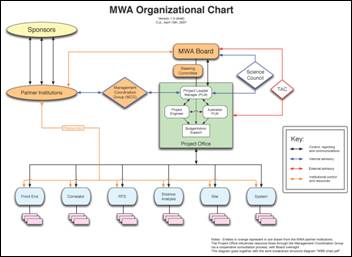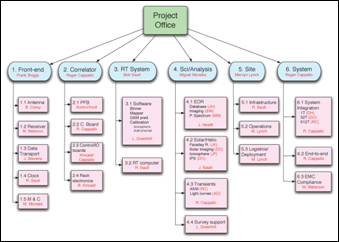Organizational Structure
The Murchison Widefield Array is a joint project with the following partner institutions:
- Massachusetts Institute of Technology (MIT)
- MIT Haystack Observatory (Project Office)
- MIT Kavli Institute
- The Harvard-Smithsonian Center for Astrophysics (CfA)
- A consortium of several Australian Universities led by the University of Melbourne (AU Project Office)
- The Australian National University
- The Australia Telescope National Facility (ATNF) of CSIRO, Australia
- The Raman Research Institute, India
Project Structure
Below is a chart summarizing the MWA management structure as of April 2007. In June 2007, the MWA Board consisting of representatives from the various partner institutions, reconstituted itself and has assumed the responsibilities of the Steering Committee, thus eliminating this component of the management structure. All other organizational components remain the same.
The Project Office consists of a Project Leader/Manager (Dr. C. J. Lonsdale, MIT Haystack Observatory), an Australian Project Leader/Manager (Dr. R. Sault, University of Melbourne), and a Project Engineer (Dr. Roger Cappallo, MIT Haystack Observatory), and oversees six major project elements listed in the blue boxes. These include the MWA Front End (antennas, receivers etc), the Correlator, the Real-Time System (RTS), the Science Analysis, the Site (infrastructure, deployment and operations), and the System Design (system integration etc). Managers of these six major elements are responsible for coordinating and overseeing the various work packages within the major elements.
The six major elements of the MWA and their managers, and the next level of work packages and their managers are presented below.
Coordination of the various work-packages is conducted on a regular basis through special meetings, teleconferences, and a Knowledge Tree/Twiki system. An all-hands major project meeting is held face-to-face every six months, followed by more topical minor project meetings every three months. Less formal meetings are held amongst the work package groups on a biweekly basis and at the discretion of the managers.
The Management Coordination Group meets on a weekly basis by teleconference to review management issues, and the Project Office meets weekly by teleconference to ensure that the efforts are well coordinated. The Technical Advisory Committee reviews the project at roughly six month intervals.
The MWA project sponsors include the US National Science Foundation (Division of Astronomical Sciences, Division of Atmospheric Sciences, and the MPS Office of Multidisciplinary Activities); the Air Force Office of Scientific Research, the Smithsonian Institution, the Australian Research Council, the Department of Education, Science and Training in Australia, the government of Western Australia, and the Raman Research Institute of India. Additional support is also provided through institutional contributions from the various partner institutions in the project.



